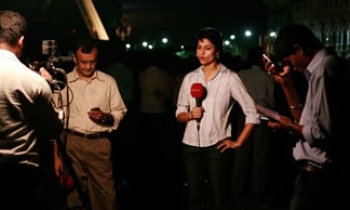It is being seen as a move not quite in tune with the times ? the decision of the New York Times to put its columnists behind a paywall has not made it very popular on the Web. At a time when newspapers are going out of their way to accommodate citizen journalists on the websites, and making way for blogging channels on their online homes, NYT has launched TimesSelect and made its most read writers practically invisible on the Web.

One of the key factors that drove visitors to NYTimes.com was said to be its team of op-ed writers. Those addicted to the writers are livid that from September 19 they will have to fork out $49.95 to keep track of these columnists. Regular visitors have reason to feel incensed. But they are not the only ones who have flayed the NYT move.
Grassroots journalism advocate Dan Gillmor wrote: "Count me among the naysayers about the New York Times' move to put columnists behind a paywall. By rendering the publication's most interesting assets invisible on the Web -- if I were a Times columnist I would be furious -- the paper is reducing its authority in the real world in an understandable effort to show better numbers for the online operation."
Director of the World Editors Forum Bertrand Pecquerie says, " I consider an opportunity was missed in the struggle for the newspaper industry to reinvent a new business model. And I hope this missed opportunity will serve as a lesson in other countries as in the US." He feels, " The Times decision to make its own and lonely policy is risky: not because web editors and bloggers will copy and paste the columns some will disseminate, but because a majority of them will ignore the Times columnists and will find their "honey" in other sources."
The Op-Ed columnists of NYT are regarded as its crown jewels: David Brooks, Maureen Dowd, Thomas L. Friedman, Bob Herbert, Nicholas D. Kristof, Paul Krugman, Frank Rich, and John Tierney, among others. Times executives believe that their loyal readers will pay up rather than lose the connection with these columnists.
For many of the columnists -- used to a huge worldwide audience for their work -- "this will be a hard shift," Times editorial page editor Gail Collins told Steve Outing, senior editor with the Poynter Institute for Media Studies. Nevertheless, she claimed that they've been supportive of the decision. Even Friedman, who writes on international affairs and has an especially strong reader base in the Middle East, acknowledged to Collins that "we have to do this."
Outing wrote: Outing: "Steve Klein, an online journalism professor at George Mason University, says one of his students raised an excellent point during a class discussion this week about TimesSelect: ?Even if the Times picked up most of its existing online readers, how are they going to grow a new generation of online Op-Ed readers if they keep the columnists behind a pay firewall?’ Good question."

Jay Rosen of PressThink argues, If everyone is reading a columnist, that makes the columnist more of a must have. If "everyone" isn’t, less of a must. "Exclusive online access" attacks the perception of ubiquity that is part and parcel of a great columnist’s power. In his prime Walter Lippmann was called "the name that opened every door." Nick Kristof’s brand of human rights journalism, which depends on the mobilization of outrage, is simply less potent if it can’t reach widely around the world, and pass by every door.
Back home, not many papers here in India keep their content behind paywalls, though some require a formal registration on the site. The only paper which keeps its columnists behind a pay-for wall is Hindustan Times. In fact, even its edits are available only to paid subscribers. That should not be a cause for worry because if recent statistics are anything to go by, Indians prefer speed of news delivery to depth of analysis as far as news is concerned.
To digress back ? so, how long will it take for things to crystallise? JD Lasica goes on to predict in his New Media Musings: "It will marginalise the Times' editorial voice in profound ways", and then sounds the death knell: " This experiment will fail inside of 12 months." That, however, may or may not be far-fetched. But in a year's time, it will certainly be more than clear who is ahead of or behind the Times.









